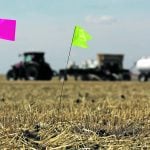Evaluating the performance of a new technology or product on your farm is difficult but I believe the rewards could put jingle in your jeans, rather than your dealer’s and supplier’s.
Tag Archives Agronomy Precisely

Taking a look at what we can learn from the previous year
Some people have been quoted as saying, “you can’t teach an old dog new tricks.” Well folks, I moved into the “old dog” classification a few years ago, but I’m trying to defy falling into the “can’t teach” part of this. As a result, each year at this time I try to reflect on the […] Read more

New field strategy needed to control wheat midge
A recent change may have a seismic effect on wheat and durum growers across Western Canada. In December 2020, the Pest Management Regulatory Agency issued an update on the re-evaluation of the insecticide chlorpyrifos, announcing that chlorpyrifos would be phased out as follows: Last date of sale by registrant: Dec. 10 2021 Last date of […] Read more

Grade farmers’ nutrition efforts on nitrogen curve
Commodity prices continue to stay strong, but input prices such as seed and fertilizer are also at record levels. While the two should have a moderating effect when it comes to over-applying an input such as nitrogen, in many cases this doesn’t seem to be the case. For years I was a strong advocate of […] Read more

Farmers must understand ag’s carbon, nitrogen cycles
It’s been a while. Summer and life have got in the way of me finishing this column. Sorry, I had a lot of positive feedback on my last column in May. In it I discussed the reason for the desire for crop-based agriculture to reduce greenhouse gas emissions from fertilizer application by 30 percent below […] Read more

Cover crops need to be planned before planted
Cover cropping comes in a few types and shoulder or relay takes over where spring crops end — if you have the weather for it
Cover crops have gained a lot of attention over the last few years, in the press, and in coffee row discussions. Most farmers have an opinion. I experienced one discussion earlier this winter between two farmers. Both argued points and both were correct. However, they were arguing two perspectives and using two entirely different definitions […] Read more
Predict your yields for 2022
The western Canadian agricultural industry saw a brutal year in 2021. It was frustrating to have record prices for grain and then have Mother Nature turn on us and not provide the wherewithal to produce crops to take advantage of them. With many crops yielding much below half of what is considered average in any […] Read more

Special nutrient management required in drought years
My previous column discussed drought and the history of droughts on the Prairies and the northern U.S. Plains over the last 100 years. This column will discuss nutrient management in drought scenarios. We will look at this topic through the lens of 4-R nutrient stewardship; right rate, right place, right time, right source. The first […] Read more

Putting this year’s drought into a prairie perspective
I recall sitting in a room in the John Mitchell building on the University of Saskatchewan campus. First day in a soil fertility class. The professor walked in and said, “just remember, the most limiting nutrient in crop production in Saskatchewan is water.” as he scrawled H20 under the heading “Key Nutrients”. OK, let’s talk […] Read more

Kochia becomes major problem across Western Canada
A couple of years ago I wrote a number of articles under “The Weed of The Week” heading. This column might be headed “The Weed of the Year.” From what I have seen in the fields, and from phone calls and texts I have received, kochia, which I have previously referred to as the scourge […] Read more






